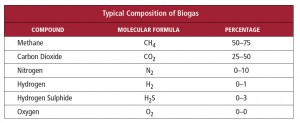
Part 2: Biogas Mass Flow Measurement--The Challenge

 Table 1 : Typical Compositional Changes in Biogas
The Problem: How to measure biogas and manage variable composition
Since the biogas composition is critical to its energy producing value, facilities need to assess the best flow meter measurement technology to manage the compositional changes in biogas. Many companies with varying technologies are interested in measuring the biogas as it leaves the landfill or digester tank, but this is a challenging application for many reasons. These include:
Table 1 : Typical Compositional Changes in Biogas
The Problem: How to measure biogas and manage variable composition
Since the biogas composition is critical to its energy producing value, facilities need to assess the best flow meter measurement technology to manage the compositional changes in biogas. Many companies with varying technologies are interested in measuring the biogas as it leaves the landfill or digester tank, but this is a challenging application for many reasons. These include:
- Varying gas compositions (see Table 1) make accurate measurements difficult because most meters are calibrated for one gas or mixture; when the composition changes, the flow measurements are no longer accurate and the meter must be recalibrated.
- Low pressure makes differential pressure devices like orifice plates unsuitable since they require a fairly large differential pressure to operate.
- Biogas is often very dirty, with a high moisture and particulate content that can clog up devices like annubars and orifice plates and gum up turbine meters and similar instruments that have moving parts.
 Go to Autotest Division >
Go to Autotest Division >